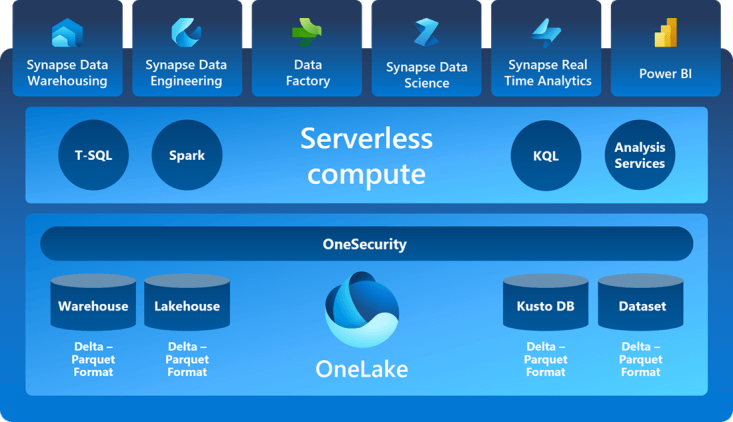

Organizations of all sizes need to be able to extract insights quickly and easily from their data to make informed decisions. But with so much data coming from so many different sources, it can be a challenge to get a complete and unified view.
That’s where Microsoft Fabric comes in. Microsoft Fabric is an all-in-one analytical solution for enterprises that covers everything from data movement to data science, real-time analytics and business intelligence. It offers a comprehensive suite of services, including a data lake, data engineering, and data integration, all in one place.
Fabric combines the best of Power BI, Azure Synapse, and other Microsoft products to make it easy for data scientists, business analysts, and other data professionals to work together to get the most out of their data.
Integrating Microsoft Fabric with other tools
There are a few different components that work together to produce actionable items.
- A world-class Spark platform provides data engineering with great authoring experiences, enabling data engineers to perform large-scale data transformation and democratize data through the lakehouse.
- Azure Data Factory combines the simplicity of Power Query with the scale and power of Azure Data Factory.
- Data scientists are empowered to enrich organizational data with predictions and allow business analysts to integrate those predictions into their BI reports.
- Data warehouse experience provides industry leading SQL performance and scale. It fully separates compute from storage, enabling independent scaling of both components.
- Real-time analytics is best-in-class engine for observational data, which is collected from various sources such as apps, IoT devices, human interactions and so many more. It’s currently the fastest growing data category.
- Power BI is the world’s leading business intelligence platform. It ensures that business owners can access all the data in Fabric quickly and intuitively to make better decisions with data.
Most of the things will not need development for the coding part. Only a few configurations are required like setting up data pipelines for continued data integration.
Benefits of Microsoft Fabric
- Connectors: Get everything in one place via data gathering from than 300+ sources.
- Comprehensive platform: Fabric is a comprehensive platform that provides a wide range of data management, analytics and machine learning capabilities.
- Ease of use: Fabric is designed to be easy to use, even for users with limited technical expertise. This makes it accessible to a wide range of users.
- Microsoft ecosystem integration: Fabric is tightly integrated with other Microsoft products and services, such as Azure Synapse Analytics, Azure Databricks, and Power BI. This makes it easy for organizations to use Fabric to build and deploy end-to-end data solutions.
Microsoft Fabric architecture
Microsoft Fabric is a cloud-based, unified data platform that provides a wide range of data management, analytics, and machine learning capabilities. It is built on an open lakehouse architecture, which combines the best of data warehouses and data lakes. This makes it easy to ingest, store, process, and analyze data of all types, from structured to unstructured.
Fabric is built on top of Azure Synapse Analytics, which is a fully managed, petabyte-scale analytics service that combines the speed and performance of a data warehouse with the flexibility and scalability of a data lake. Fabric also integrates with other Azure services, such as Azure Databricks, Azure Machine Learning, and Power BI, to provide a complete end-to-end data solution.
The Fabric architecture is designed to be scalable, secure and reliable. It uses a distributed architecture to handle large volumes of data and concurrent users. Fabric also uses industry-leading security features to protect data from unauthorized access.

Leveraging Microsoft Fabric for data analytics
Airlines have many responsibilities, including:
- Managing a database of plane tracking information and location data. This data is constantly streaming in from different planes, so airlines need to be able to handle it efficiently. This data is used to track the location of planes in real time, which is essential for ensuring safety and efficiency.
- Manage maintenance and contracts for aircrafts leased from lessors. This can involve complex decisions such as when to schedule maintenance, which aircraft to lease, and how to negotiate contracts with lessors. Airlines need to make sure that their aircrafts are properly maintained to ensure safety and reliability.
- Making complex decisions to improve services, such as reducing the cancellation ratio by offering discounts to passengers. Airlines need to be able to analyze data from a variety of sources, such as customer feedback, flight data, and market trends, to make informed decisions about how to improve their services.
Microsoft Fabric can help airlines with all these responsibilities by providing a unified platform for data management, analytics, and machine learning. Fabric can help airlines to:
- Ingest and manage data from a variety of sources, including plane tracking systems, maintenance records, and customer feedback data.
- Transform data into a format that is easy to analyze.
- Analyze data using a variety of tools and techniques, including machine learning.
- Share insights with others in the organization through interactive reports, dashboards, and data stories.
For example, airlines can use Fabric to develop machine learning models that can predict the likelihood of flight cancellations. This information can then be used to proactively take steps to reduce cancellations, such as offering discounts to passengers on flights that are at risk of being cancelled.
Overall, Microsoft Fabric can help airlines make better decisions, improve their services and reduce costs.

Introduction to MAUI for business leaders
Date: Thursday, Dec 14, 2023
Time: 11:00 AM TO 11:30 AM CT
Webinar agenda
- What is MAUI?
- How MAUI differs from Xamarin
- Other key features of MAUI
- Business benefits of adopting MAUI
- Getting started with MAUI
- Q&A
How airlines can use Microsoft Fabric:
To improve fuel efficiency, airlines can use Fabric to analyze data on aircraft performance, weather conditions and flight routes. This information can then be used to optimize flight plans and reduce fuel consumption.
To improve customer service, airlines can use Fabric to analyze data on customer feedback, social media posts, and flight delays. This information can then be used to identify areas where customer service can be improved.
To reduce costs, airlines can use Fabric to analyze data on maintenance costs, aircraft utilization and fuel consumption. This information can then be used to identify areas where costs can be reduced.
Microsoft Fabric is a powerful tool that can help airlines improve their operations in a variety of ways.
Conclusion
Microsoft Fabric is a powerful and versatile data platform that can help organizations of all sizes improve their operations in a variety of ways. It is built on an open lakehouse architecture, which combines the best of data warehouses and data lakes, and it integrates with other Azure services to provide a complete end-to-end data solution.
Softweb Solutions provides a wide range of Microsoft Fabric data analytics services, including:
- Data integration and warehousing
- Data transformation and cleansing
- Data visualization and analytics
- Predictive analytics
- Machine learning
Contact our data experts to leverage the full potential of Microsoft Fabric and gain a competitive advantage in this digital era.
AI Workshop
Envision how your AI Journey can be in next 1-3 years from adoption and acceleration perspective.
Enroll NowNeed Help ?
We are here for you